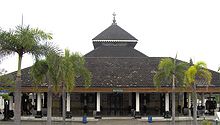Demak Great Mosque: Difference between revisions
OktaRama2010 (talk | contribs) m added Category:Demak Regency using HotCat |
IndonesianM (talk | contribs) No edit summary |
||
| Line 2: | Line 2: | ||
{{Infobox religious building |
{{Infobox religious building |
||
| building_name = ''Demak Great Mosque'' |
| building_name = ''Demak Great Mosque'' |
||
| native_name = ''Masjid Agung Demak '' |
| native_name = ''Masjid Agung Demak '' <br>'''مَسجِد اَگَوڠ دَمَق''' |
||
| native_name_lang = |
| native_name_lang = |
||
| image = Masjid_demak.jpg |
| image = Masjid_demak.jpg |
||
| Line 65: | Line 65: | ||
}} |
}} |
||
'''Demak Great Mosque''' ({{lang-id|Masjid Agung Demak}}) is one of the [[List of the oldest mosques in the world#Eurasia|oldest]] [[List of mosques in Indonesia|mosques in Indonesia]], located in the center town of [[Demak, Indonesia|Demak]], [[Central Java]], [[Indonesia]]. The mosque is believed to be built by the ''Wali Songo'' ("Nine Muslim Saints") with the most prominent figure [[Sunan Kalijaga]], during the first [[Demak Sultanate]] ruler, [[Raden Patah]] during the 15th century.<ref name="FloridaDUP1995">{{cite book |last=Florida |first=Nancy K. |title=Babad Jaka Tingkir: Writing the past, inscribing the future: history as prophesy in colonial Java |location=[[Durham, North Carolina|Durham, N. C.]] |publisher=[[Duke University Press]] |year=1995 |chapter=5: The Demak Mosque: A Construction of Authority |isbn=0-8223-1622-6}}</ref> |
'''Demak Great Mosque''' ({{lang-id|Masjid Agung Demak}}, [[Pegon script|Pegon]]: '''مَسْجِد اَگَوڠ دَمَق''') is one of the [[List of the oldest mosques in the world#Eurasia|oldest]] [[List of mosques in Indonesia|mosques in Indonesia]], located in the center town of [[Demak, Indonesia|Demak]], [[Central Java]], [[Indonesia]]. The mosque is believed to be built by the ''Wali Songo'' ("Nine Muslim Saints") with the most prominent figure [[Sunan Kalijaga]], during the first [[Demak Sultanate]] ruler, [[Raden Patah]] during the 15th century.<ref name="FloridaDUP1995">{{cite book |last=Florida |first=Nancy K. |title=Babad Jaka Tingkir: Writing the past, inscribing the future: history as prophesy in colonial Java |location=[[Durham, North Carolina|Durham, N. C.]] |publisher=[[Duke University Press]] |year=1995 |chapter=5: The Demak Mosque: A Construction of Authority |isbn=0-8223-1622-6}}</ref> |
||
== Features == |
== Features == |
||
Revision as of 18:31, 3 April 2022
| Demak Great Mosque | |
|---|---|
Masjid Agung Demak مَسجِد اَگَوڠ دَمَق | |
 | |
| Religion | |
| Affiliation | Islam |
| Province | Central Java |
| Region | Demak |
| Location | |
| Location | Jalan Sultan Fatah, Bintoro Demak, Central Java, Indonesia |
| Administration | Demak government |
| Geographic coordinates | 6°53′41″S 110°38′14″E / 6.8947°S 110.6373°E |
| Architecture | |
| Architect(s) | Sunan Kalijaga |
| Style | Javanese |
| Completed | 1479 |
| Minaret(s) | None |
Demak Great Mosque (Template:Lang-id, Pegon: مَسْجِد اَگَوڠ دَمَق) is one of the oldest mosques in Indonesia, located in the center town of Demak, Central Java, Indonesia. The mosque is believed to be built by the Wali Songo ("Nine Muslim Saints") with the most prominent figure Sunan Kalijaga, during the first Demak Sultanate ruler, Raden Patah during the 15th century.[1]
Features
Although it has had a number of renovations, it is thought to be largely in its original form. It is a classic example of a traditional Javanese mosque. Unlike mosques in the Middle East it is built from timber. Rather than a dome, which did not appear on Indonesian mosques until the 19th century, the roof is tiered and supported by four saka guru teak pillars. The tiered roof shows many similarities with wooden religious structures from the Hindu-Buddhist civilizations of Java and Bali. The main entrance of Masjid Agung Demak consists of two doors carved with motifs of plants, vases, crowns and an animal head with an open wide-toothed mouth. It is said that picture depicts the manifested thunder caught by Ki Ageng Selo, hence their name Lawang Bledheg (the doors of thunder). Like other mosques of its era, its orientation towards Mecca is only approximate.[2]
Carving and historical relics

Its walls contain Vietnamese ceramics. With their shapes derived from conventions of Javanese woodcarving and brickwork, they are thought to have been specially ordered. The use of ceramic rather than stone is thought to have been in imitation of the mosques of Persia.[3]
Gallery
-
Masjid Agung Demak, end of 19th century
-
1920-1939
-
August 2016
-
Minaret, August 2016
See also
References
- ^ Florida, Nancy K. (1995). "5: The Demak Mosque: A Construction of Authority". Babad Jaka Tingkir: Writing the past, inscribing the future: history as prophesy in colonial Java. Durham, N. C.: Duke University Press. ISBN 0-8223-1622-6.
- ^ Turner, Peter (November 1995). Java. Melbourne: Lonely Planet. pp. 78–79. ISBN 0-86442-314-4.
- ^ Schoppert, Peter; Damais, Soedarmadji & Sosrowardoyo, Tara (1998), Java Style, Tokyo: Tuttle Publishing, p. 41, ISBN 962-593-232-1














